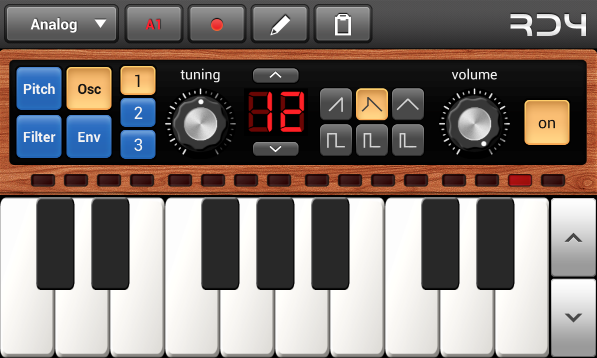Choices may be scarce on Android, but there’s a unique amount of passion behind this platform. Choose a high-quality app and the right device, and you can get low-latency audio and even cool features like USB host mode that let you connect a mouse, keyboard, joystick, or MIDI keyboard. (Well… sort of. See disclaimers below.)
mikrosonic’s polished RD4 groovebox continues to mature. It’s arguably the studio to beat on the Android platform. It sounds great, does the things you need, and could give you hours of fun tinkering with music on the bus and plane or in a coffee shop. You just need a recent tablet or phone to really take advantage of it – and, ideally, a Nexus 4, Nexus 10, or Galaxy Nexus for optimal audio performance that can rival iOS.
The just-released version 2 upgrade brings more features. There’s a “70s-style” (Minimoog-influenced, subtractive) synth. And there’s a four-channel Rack that lets you combine Analog, the Bassline instrument, and the drum machine.
Put together, you have something that recalls the simple fun of tools like Propellerhead’s original ReBirth; acid techno or other dance music is easily under your fingertips. I think what’s especially nice about RD4 is that you don’t get the sense the UI has been overcrowded; this is no desktop app crammed onto a touchscreen. It seems the interface has been designed around your fingertips.
As with any well-engineered Android app, though, device choice is everything. mikrosonic has just published an FAQ that’s must-read material even if you don’t intend to use RD4; it’s one of the more comprehensive guides to the real-world performance of Android music devices I’ve seen:
http://www.mikrosonic.com/faq
It repeats my advice about using certain Nexus gadgets for low-latency, reliable audio. But it also has tips for OS versions, storage, connecting to your computer (which turns out to be easier, perhaps, than on iOS), MIDI keyboards and audio interfaces.
Actually, the MIDI keyboard issue is especially maddening:
Yes, we are working on it. Android 3.1 and later does support to connect MIDI devices through USB. But there is no standarised way how to access the specific MIDI device, so each app has to implement its own interface. We are working on a practical solution.
I still can’t even come close to recommending Android as a music platform. I would always choose an iPhone over an Android phone, an iPad over an Android tablet, for all the reasons above, when it comes to music making. At the same time, it’s very likely you might wind up with an Android phone or tablet because it was a better choice for other reasons. Checking out the advice here is absolutely advisable.
I think you’ll also find, reading through the FAQ, many of these issues are generally fixable. So I hope Google and vendors pay attention. If you’re out there, give RD4 a go, and do talk to us music makers. We do care about this strange activity of making music on phones and tablets, and we’d be happy to give you a hand.
And here’s a nice thing about the Google approach: there’s a demo version.
